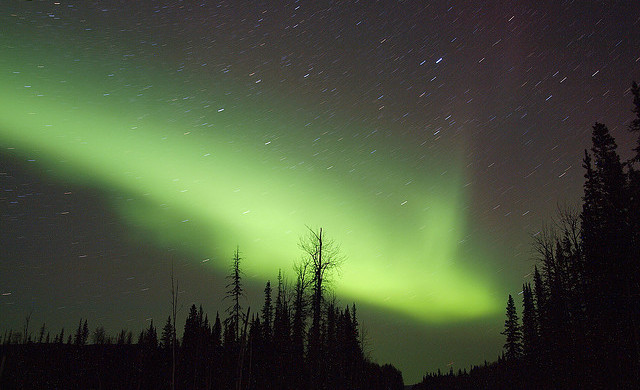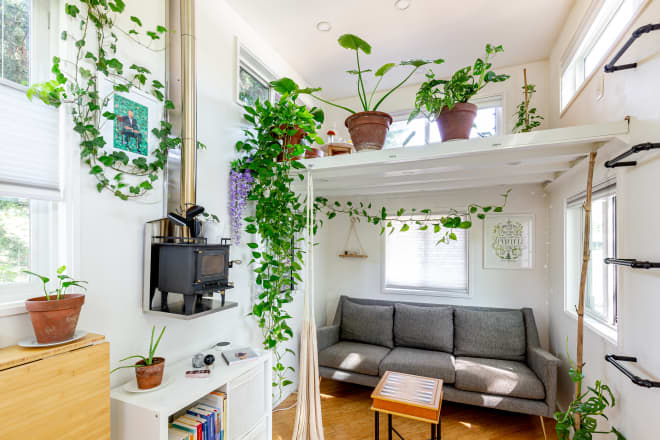National Park Week: 12 Reasons Our Travel Editors Love National Parks
National parks are so much more than just places to hike and camp.
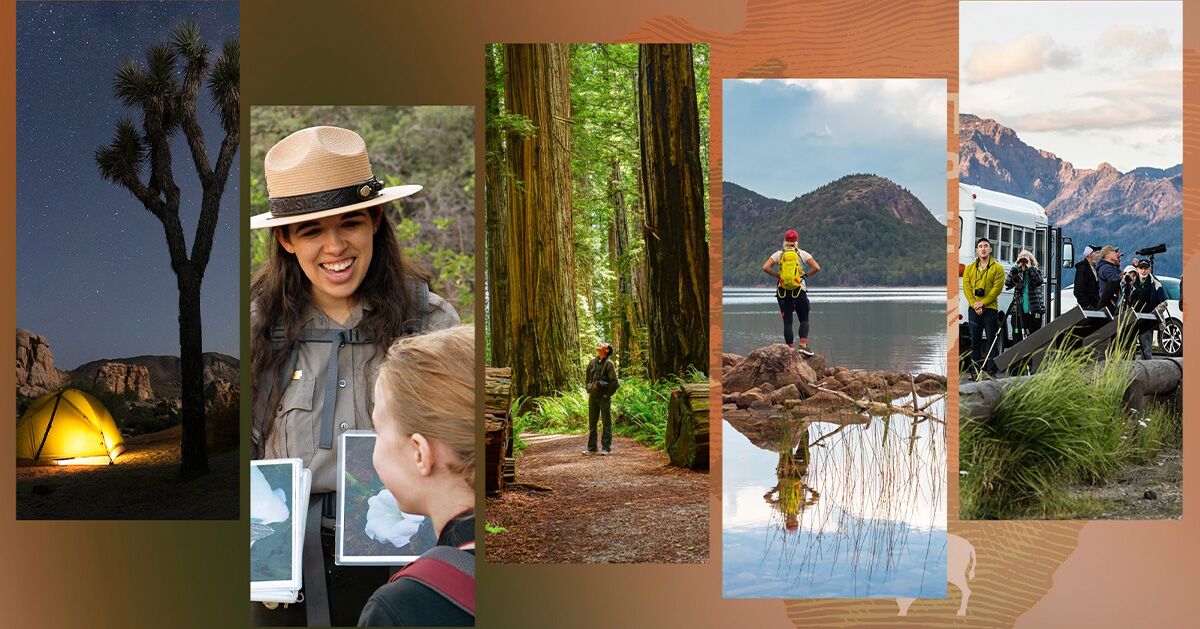
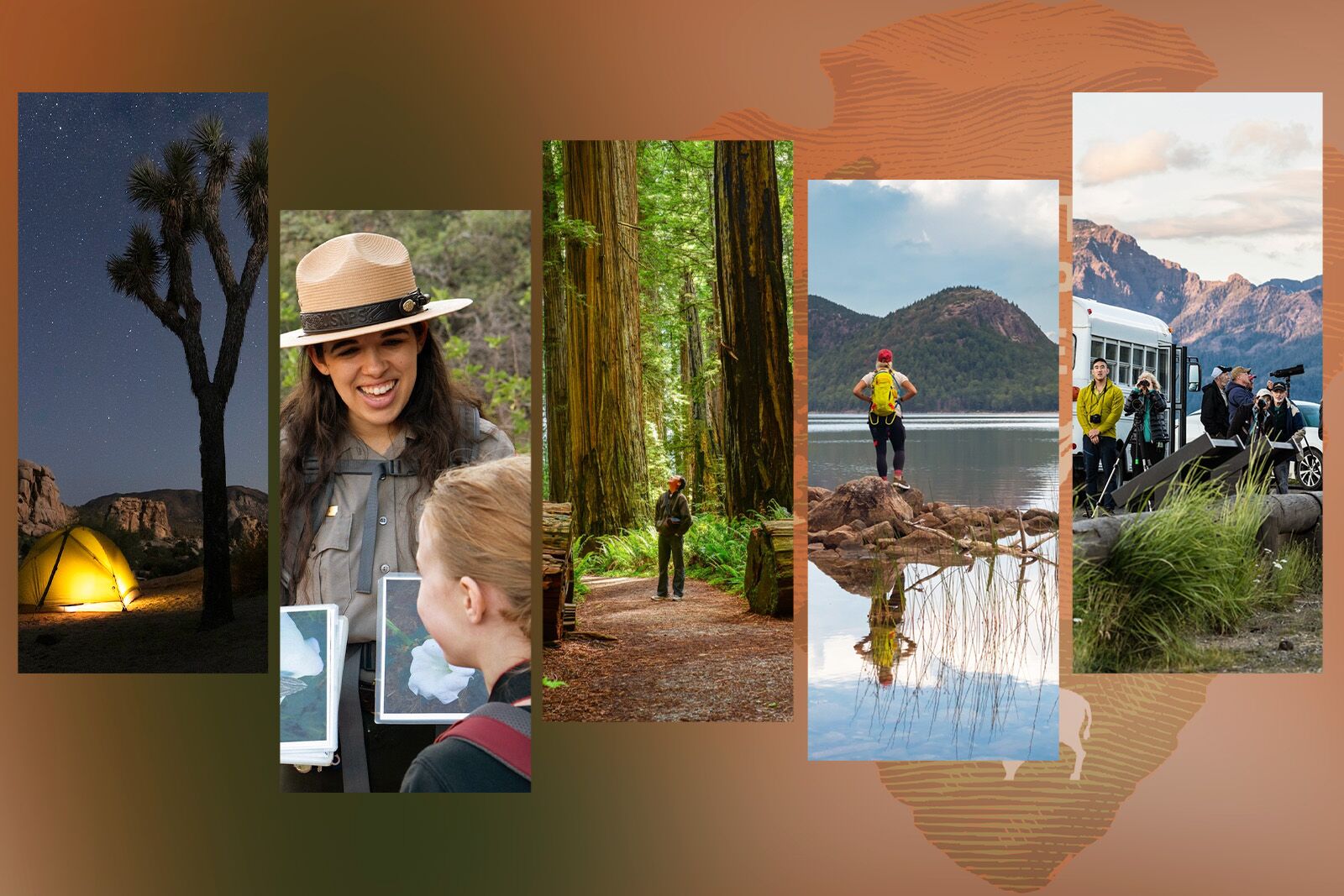
Join Matador Network in Celebrating National Park Week 2025
National Park Week, from April 19-27 in 2025, is a chance to recognize and celebrate just one segment of these public lands.
Since Matador Network’s founding in 2006, we’ve covered some of the many things that are only possible in national parks. We’ve also advocated for their protection, expansion, and use, whether that means hiking some of the most extreme trails in the world or taking a bucket-list vacation to look for wildlife in sprawling parks.
As national parks face one of the most turbulent times in their history since Yellowstone became the world’s first national park in 1872, we’re celebrating National Park Week with urgency, not just admiration. In 2024, parks received a record-breaking 331 million visits. They’re popular domestically and internationally, and aLao have a big impact on local communities: studies have found national parks generate roughly $10 in economic benefit for every $1 invested. Still, the current administration has reduced protections and threatened access to public lands as a whole. Key access points are being considered for sale to private companies and individuals, and drilling and mining contracts threaten environments that have flourished without human intervention.
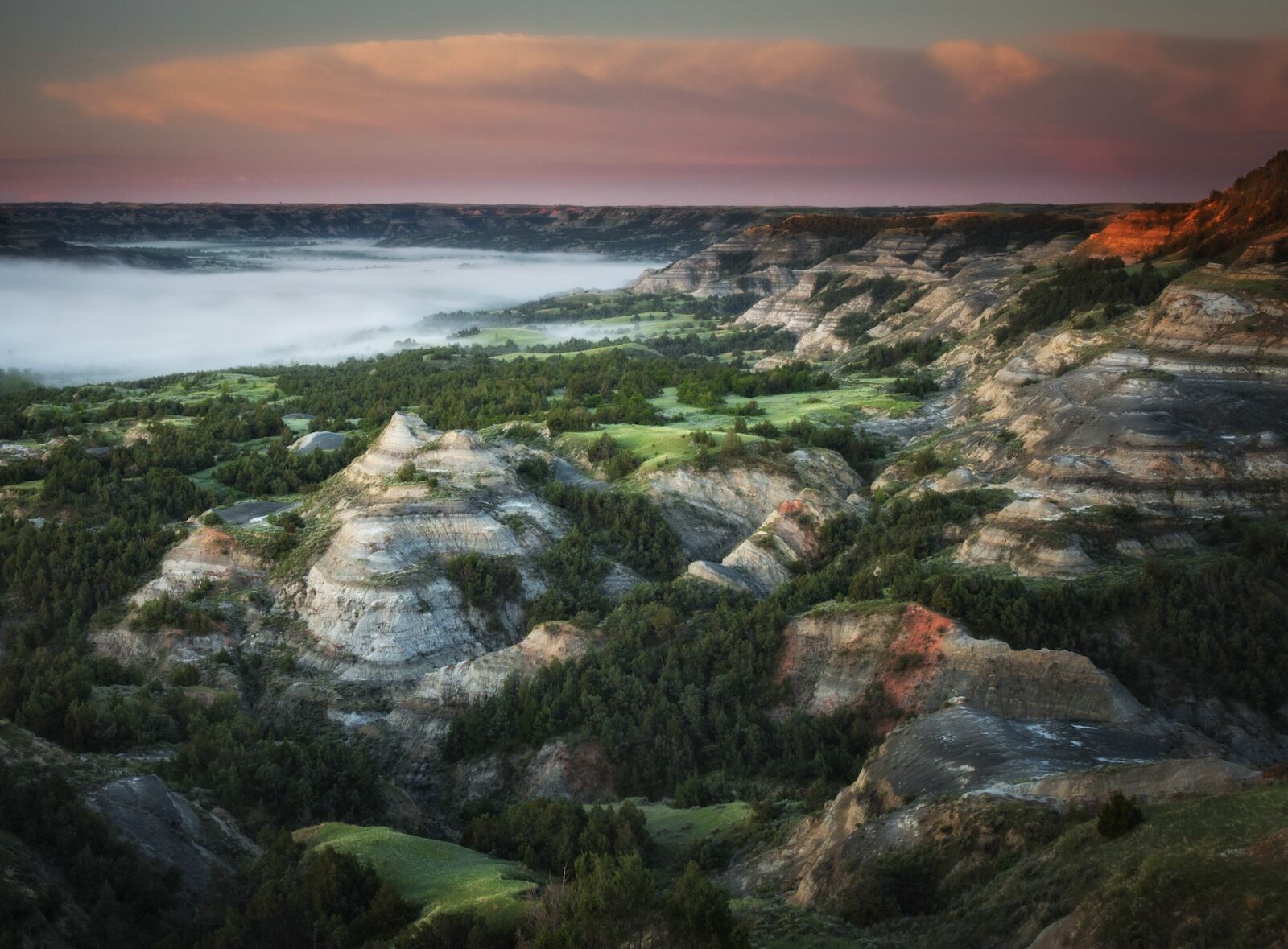
The North Unit of Theodore Roosevelt National Park. Photo: NPS/Public Domain
It’s a frightening moment for the environment. As we know, it has been, since roughly the mid-1700s, when humans started significantly contributing to climate change and making large-scale, irreversible changes to the global landscape. But
National Parks are for the people, but also for the environment. With scientists warning we’re nearing the point of no return on planetary heath, it’s more critical than ever to be part of the solution and support our national parks for ourselves and future generations.
The easiest way to do so is to share what makes our national parks so special and to encourage people to do the same. And, importantly, experience for themselves all that is possible on these public lands. For the next nine days and beyond, we encourage you to spend a few minutes a day thinking about national parks. Dream about your next long-distance hike, plan your next park vacation, and map out an overly ambitious road trip to every national park in the country.
What is National Park Week?
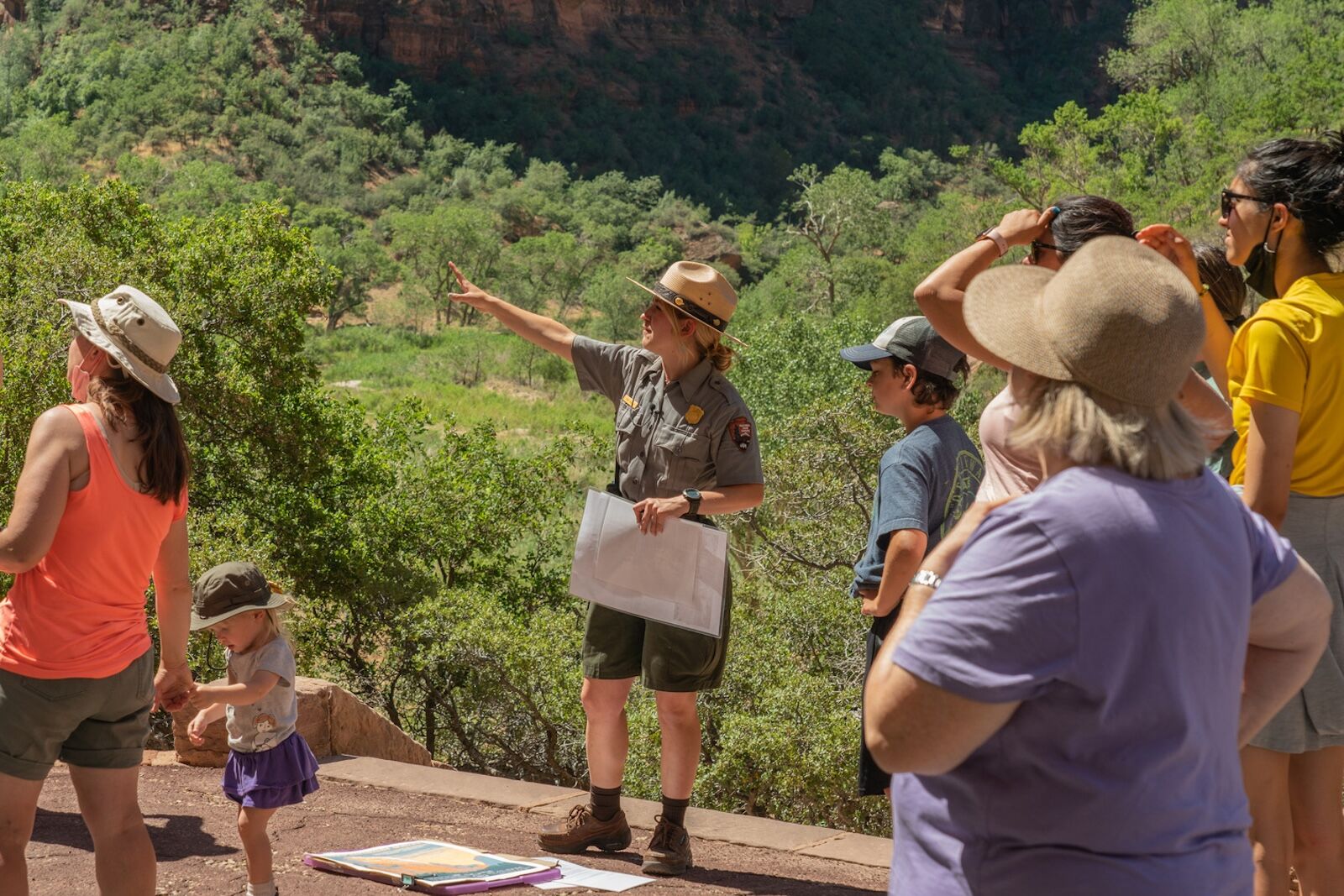
Photo: Zion National Park/NPS/Kristin Wilson
National Park Week is an annual celebration organized by the National Park Service to highlight the importance of America’s 400-plus sites managed by the agency. These sites are critical to North America’s environmental health, but also protect some of the most beautiful, historical, and culturally significant sites on the continent. While it’s technically only a US event, it’s a great chance to celebrate and explore national parks around the world. As of 2025, roughly 200 countries have some version of a national park system — though Yellowstone National Park, established on March 1, 1872, is widely recognized as the first national park in the world.
Ways to celebrate National Park Week 2025
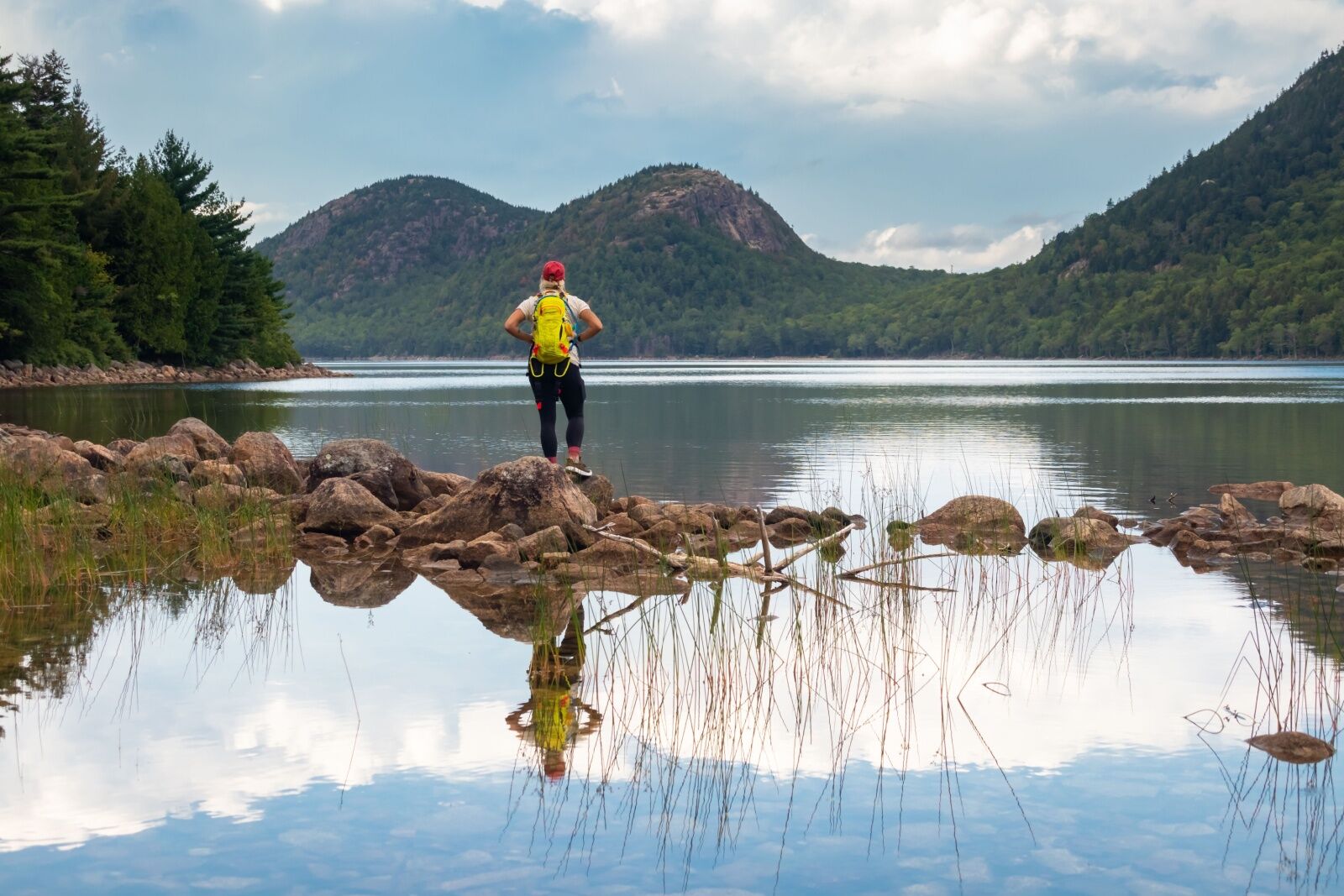
A hiker in Acadia National Park, Maine. Photo: Michael Carni/Shutterstock
In 2025, National Park Week will take place from April 19 to April 27. Almost every single site in the National Park Service system will have events going on through the week, but one thing they all have in common is a free-free day on April 19, 2025. That means admission to every single NPS site that day is free (though there are still fees for amenities, camping, etc). This year, NPS has a fun day-by-day list of activities for national park fans, whether you’re in the park, or not. Activities range from using official hashtags on certain days to sharing park photos on social media to learning about the role lesser-known figured have played in the formation of national parks.
For example, did you know that one of the first-ever people to explore and map Mammoth Caves National Park in Kentucky was Stephen Bishop? He was brought to the site while enslaved in the 1830s, taught himself geology and cave exploration, and made the first map of the entire cave system.
10 things you can do from home for National Park Week
With more than 400 sites managed by the National Park Service, getting to a site to celebrate National Park Week 2025 may be easier than you think. And it matters — showing that public parks are popular and beloved goes a long way when it comes to convincing elected officials to protect them.
But if you can’t make it to a site, you can still show your support for public parks from afar. Here are 10 ways to do it during National Park Week 2025.
- Take a virtual tour: Explore parks like Yellowstone, Grand Canyon, or Arches through digital tours and webcams, which showcase geysers, trails, and panoramic views. You can also watch live webcam at any parks. For example, you can watch Old Faithful erupt at Yellowstone, watch water cascade over massive Yosemite Falls in California, or watch Kilauea smolder in Hawai’i Volcanoes National Park.
- Create a National Park playlist: Curate music inspired by your favorite parks or trips and share it on social media using #NationalParkWeek and #NationalParkPlaylist.
- Support parks from afar: Donate to conservation organizations or directly to official park non-profits.
- Need a t-shirt or coffee mug? Shop for park-themed gear from official national park stores, or places like Landmark Project or the Parks Project.
- Volunteer locally: Plant a tree in your yard, volunteer with a local community clean-up group, or just go for a walk where you pick up any trash you see along the way.
- Enter a national parks photo contest, such as this one, running through August 2025.
- Listen to a national park podcast: Many parks themselves have their own podcasts, and NPS as a whole offers My Park Story, profiling interesting people with unique connections to parks. The National Parks Conservation Associations runs an interesting podcast called The Secret Lives of Parks, and Everybody’s National Parks blends personal stories from parks with expert interviews and insight.
- Spread the word about National Park Week 2025: Tell your friends in person, or spread the word on social media using the official National Park Week 2025 hashtag: #NationalParkWeek. Sharing photos, a quick blurb about your favorite national park memory, or even this article, will help raise awareness of national parks and their need.
- Host a National Park Week 2025 get-together: Invite friends over for a backyard bonfire (if they’re allowed where you live) or host a movie night where you stream fantastic national park shows, like Our Great National Parks on Netflix.
- Plan your next parks trip: Even if you don’t have the time off arranged, plan a hypothetical national parks vacation. Whether you’re road-tripping to Zion or doing something much, much longer, you can still have fun exploring the hotels, viewpoints, and bucket-list trails you’ll hike when you do have time to make it happen
1. National parks protect important cultural sites
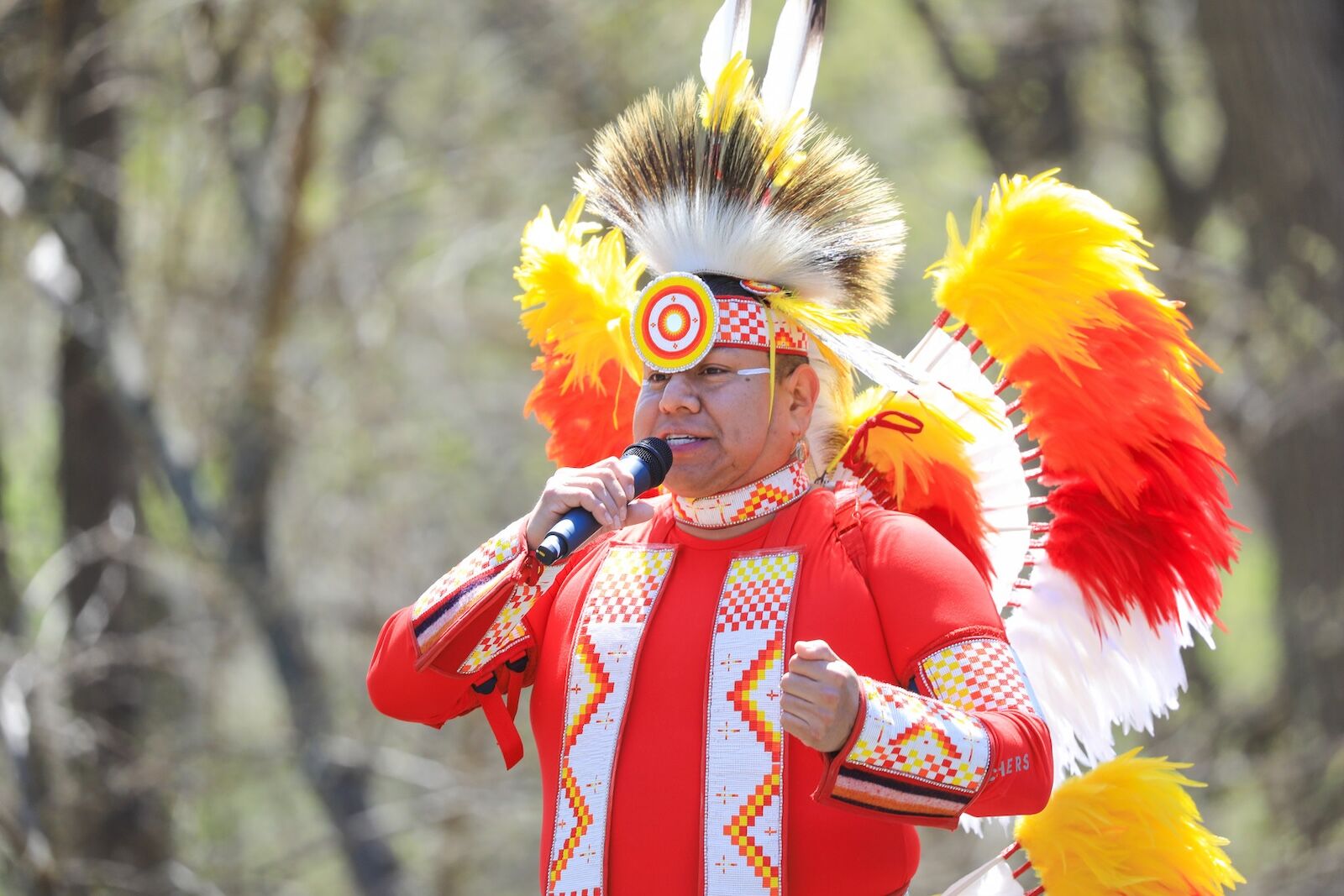
Wichita War Dancer speaks to the audience. Greg Victors, also known as the Wichita War Dancer, kicked off Homestead NHP’s National Park Week activities from 1-2 pm on April 20, 2024. Photo: /NPS
America’s national parks play a vital role in preserving the country’s cultural and historical legacies. Parks protect sacred Indigenous sites, historic landmarks, and landscapes that shaped the nation’s identity, from Civil War battlefields to sites of struggles for equality to ancient cliff dwellings. Without protections, many of these sites would be gone forever, taking away from future generations the chance learn from and reflect on pivotal moments in American history. As philosopher George Santayana said, “Those who cannot remember the past are condemned to repeat it.” Preserving and remembering our history is a chance for us to remember, honor, and learn from the high and low points in America’s complicated, fascinating history.
- Read about seven important LGBTQIA+ heritage sites in the National Park Service you should visit
- Read about three sites in California with strong Indigenous and current-day cultural links that became national monuments (or could become them soon)
- Read about recent discoveries at Alcatraz Island, an NPS site once used as a maximum security island prison
- NPS is always adding new cultural sites, like this one added last year in Marfa, Texas.
- Did you know there are dozens of UNESCO World Heritage Sites in national parks?
2. National parks support a massive outdoor economy

Visitors to national parks spend billions each year in local gateway towns. Photo: Yellowstone National Park/NPS/Jacob W. Frank
National parks are economic engines, generating billions of dollars annually through tourism. In 2023, they generated $26.4 billion in spending for communities within 60 miles of park boundaries. That meant 415,000 jobs, which means 415,000 additional people with money to spend on housing, groceries, and other businesses that keep communities healthy and thriving.
Despite these contributions, national parks operate on limited federal funding — approximately $2.5 billion annually. That makes them one of the most profitable parts of the government, all while keeping the cost to access parks extremely low.
- Read our massive investigative story on what happened 30 years ago when wolves were released back into Yellowatone National Park. (They’ve now moved as far west as California).
- Travelers Dropped $26 Billion on US Parks in 2023. Here’s Where They Went.
- Read why the fact that national parks broke a visitation record in 2024 is going to be a huge problem in 2025
- Read about a down-and-out town that was completely revitalized thanks to outdoor recreation
- Here’s why we should have more national parks in Middle and Eastern America
- The outdoor recreation industry is huge — bigger than mining and agriculture, according to a report
- Here’s why conserving land is more economical than exploiting it
3. National parks provide essential habitats for vital species
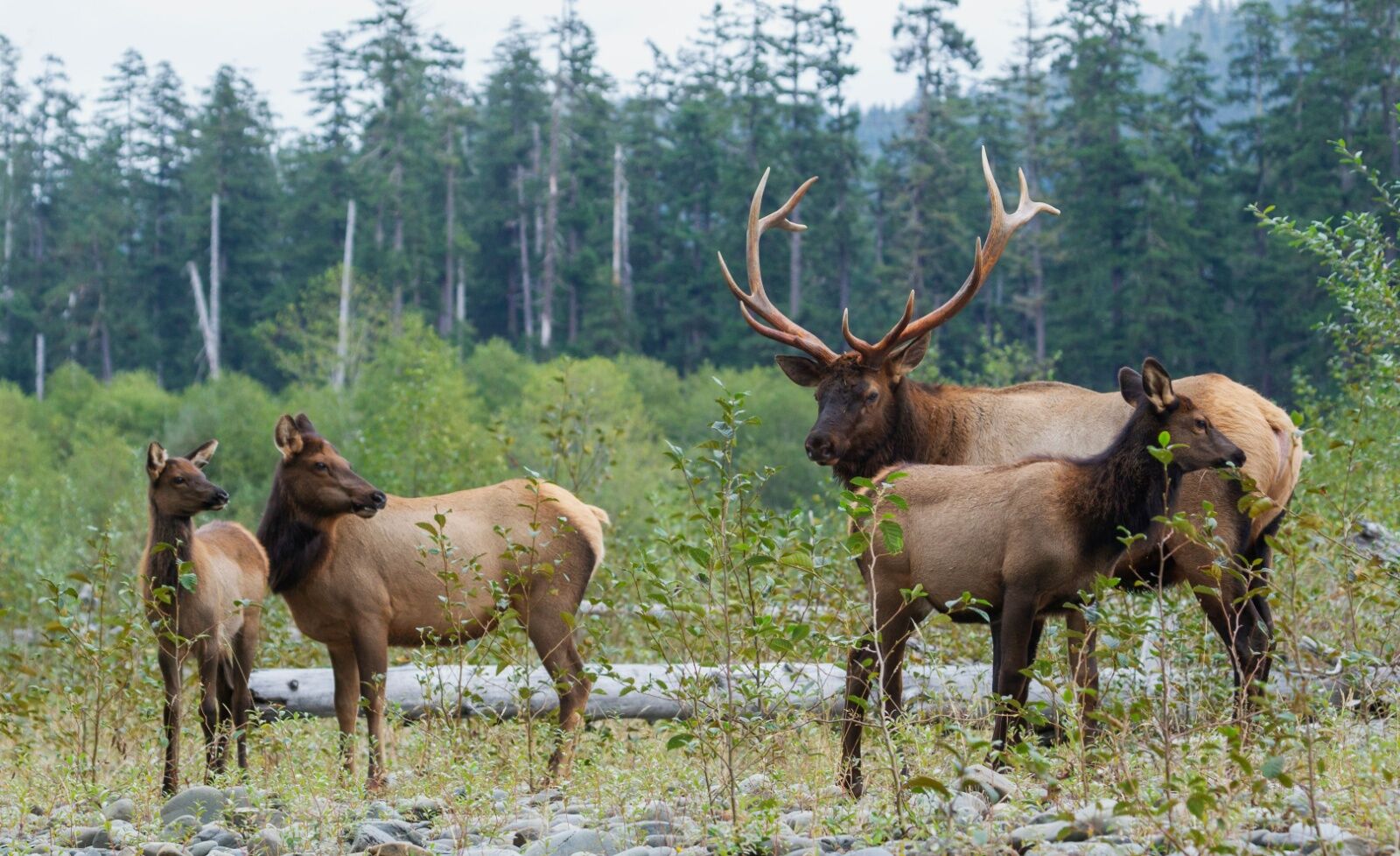
Photo: Danita Delimont/Shutterstock
The ongoing success story of wildlife in US national parks is one of the best stories of conservation in the world. Parks provide crucial habitat for thousands of species, from from iconic mammals like bison, bears, and mountain lions to lesser-known amphibians, birds, and tiny insects. Many national parks are the last remaining safe habitats for threatened and endangered species that are struggling elsewhere due to habitat loss, pollution, and climate change.
National parks allow wildlife to thrive with minimal human interference, serving as migration corridors and breeding grounds while providing safe areas to hunt and raise young away from external threats. Parks also act as natural laboratories for scientists on topics from wildlife behavior to the impacts of climate change plants and animals. Equally important, parks foster public connections to wildlife to build awareness, empathy, and a sense of stewardship. Without national parks, many species would face uncontrolled threats from development, roads, and industry, leading to a massive loss in biodiversity, and major changes to the American landscape.
4. Hiking in US national parks is some of the best in the world
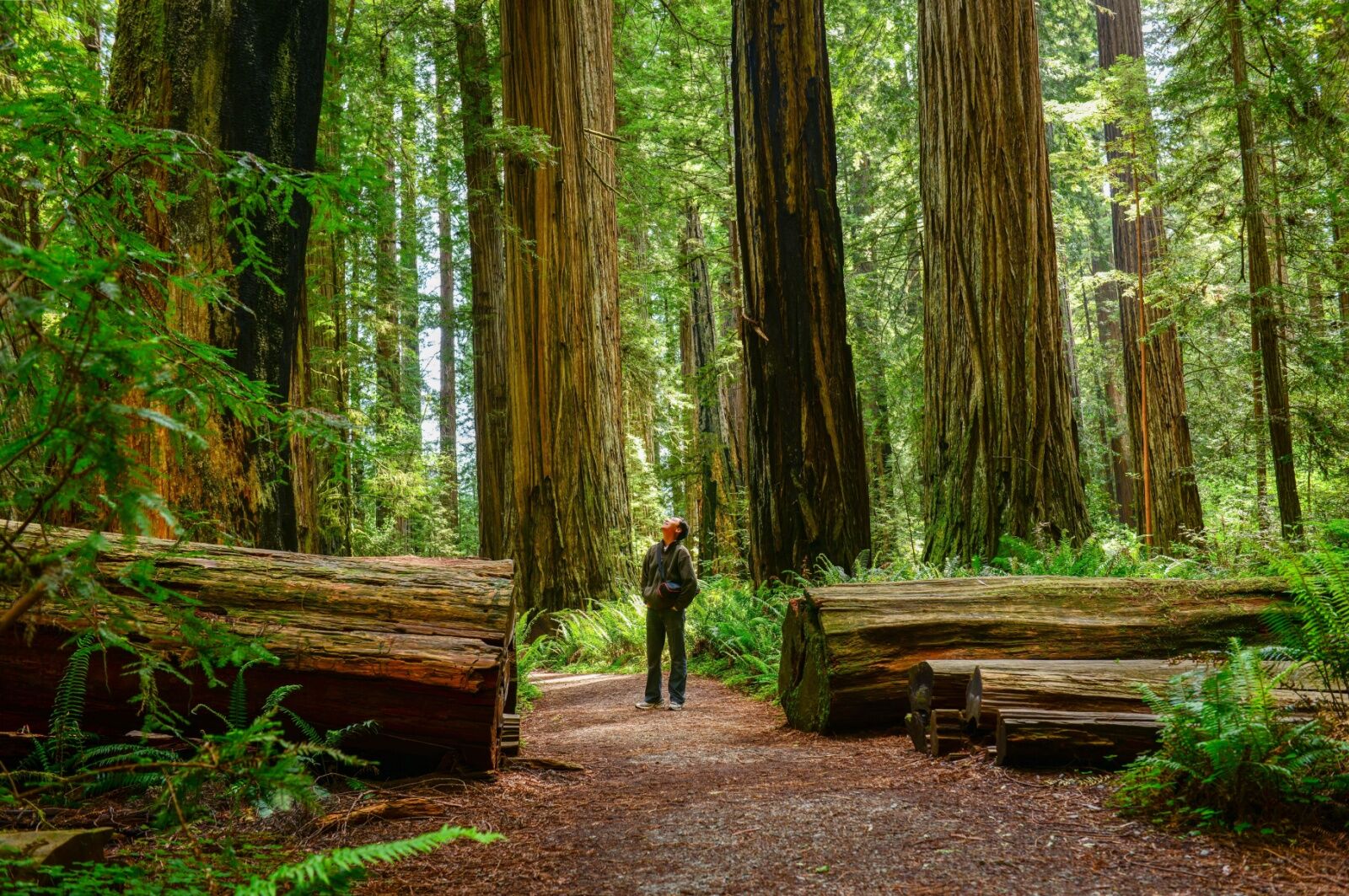
Photo: Janice Chen/Shutterstock
Hiking and walking are one of the most popular reasons people visit National Park Service sites. NPS sites have more than 21,000 miles of trails, ranging from gentle boardwalks to rugged, multi-day backcountry routes. Some of the most iconic hikes in the country are in national parks, such as the Mist Trail in Yosemite, the Appalachian sections of Great Smoky Mountains, and the high-alpine circuits of Rocky Mountain National Park. Even more bucket-list hikes, such as Mount Whitney in California, are protected as part of the US Forest Service (which is not part of the National Park Service). Trails in national parks are carefully maintained, routed in such a way so as to protect environmentally sensitive areas, and often both educational and accessible, offering ADA-compliant routes for wheelchair users and visitors with limited mobility.
- Make your plans now to apply for one of the most competitive hiking permits in the country
- Read up on America’s official scenic trails (not just the Appalachian Trail and PCT)
- Add one one of the 9 hardest hikes in the US National Park Service you can do in a day to your hiking bucket list
- Check out the gorgeous photos from one writer’s 5-day hiking trip through Yosemite and Half Dome
- If you’re headed to Zion National Park, check out the 16 least-crowded trails for avoiding people
- If you love the creepy side of park history, check out 8 haunted national park trails across the country
- Black Canyon of the Gunnison doesn’t get too crowded, but you can make it even more peaceful with these 9 crowd-free Black Canyon of the Gunnison hiking trails
5. National parks support vital, groundbreaking research and conservation
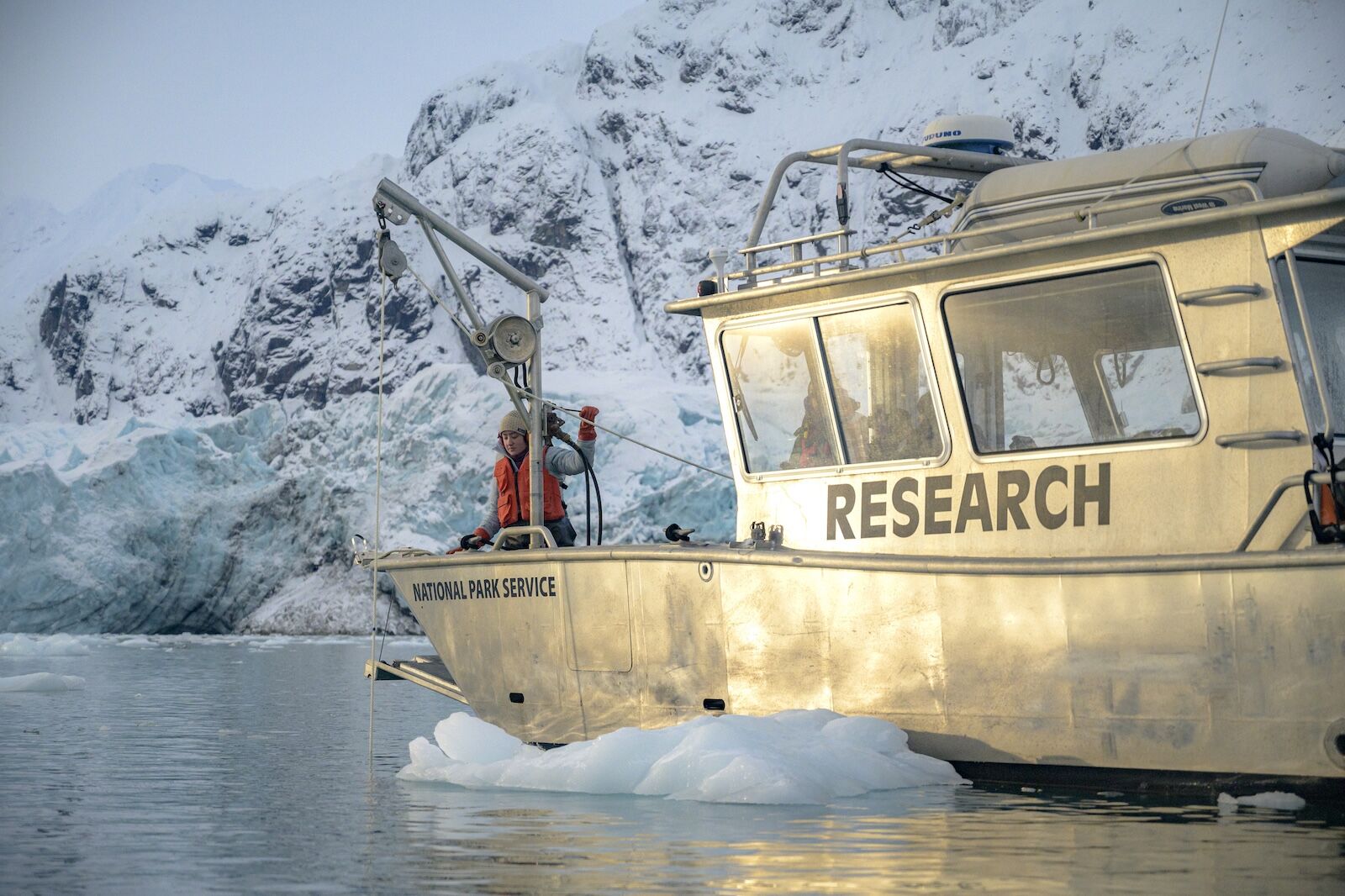
Photo: Glacier Bay National Park and Preserve/NPS/Sean Tevebaugh
National parks are ground zero for research and conservation projects, benefiting both the environment and humanity. Research in parks spans a wide range of fields, from wildlife monitoring to climate change analysis. Yellowstone’s reintroduction of gray wolves was a massive study in how apex predators are essential to balanced landscapes; the research from the park has influenced global conservation strategies. And an ongoing study in the Great Smoky Mountains on acid rain led to air pollution regulations that improved water quality for millions. The research can help humans who never even set foot in a park, through projects like pollinator studies and fire management studies in Kings Canyon National Park.
- Here’s why an initiative to protect 30 percent of the Earth by 2030 could be massive for outdoor spaces in the US
- We’re not sure if it’ll still happen, but a new EPA rule could make stargazing in some parks so much better
- Protection for Colorado’s Dolores River Canyon is controversial. But here’s why that may make it more successful.
- If the underwater world ignites your passions, check out five things you can do in five minutes to help the world’s oceans
- Read about seven animal species barely saved from extinction thanks to conservation and land protection efforts
- Learn about five key women in conservation, some of whom helped America’s favorite national parks gain their protected statuses
6. National Park Service sites have amazing campgrounds
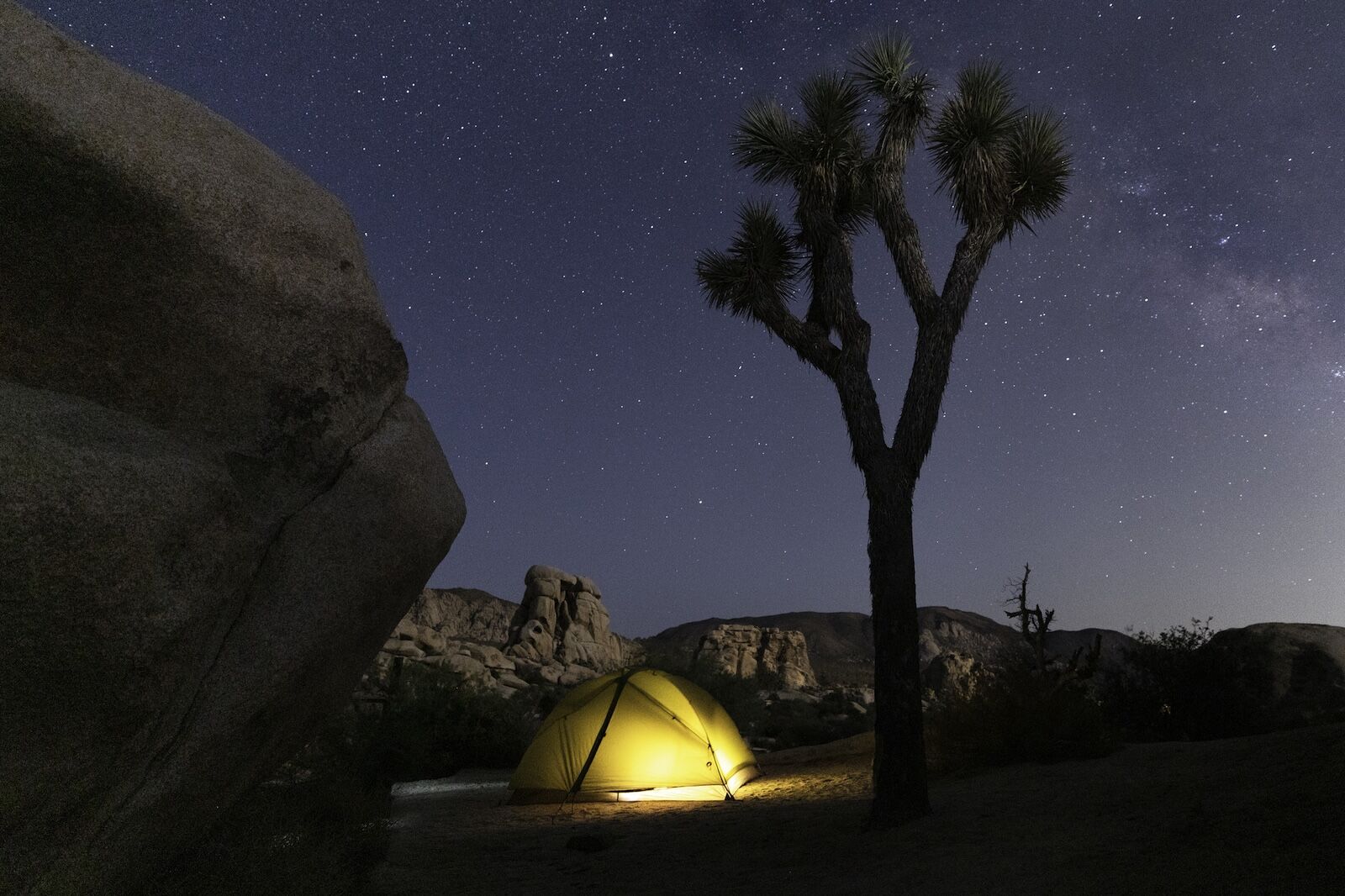
Photo: Joshua Tree National Park/NPS/Hannah Schwalbe
Camping in US national parks is a way to immerse yourself in nature, ensuring you fall asleep and wake up inside park boundaries and skip the lines of cars trying to get in each morning. There are more than 130 campgrounds in US national parks, ranging from developed campgrounds with convenient camp stores to remote backcountry sites, plus plenty of parks where you can camp wherever you like in the backcountry.
Campground reservations at front-country sites can be hard ot get, with most parks opening online reservations six to three months in advance. However, there are some parks where you can usually get a last-minute spot, like New River Gorge National Park in West Virginia or Great Basin National Park in Nevada. And if you want a backcountry site at a US national park, you may have to enter a complicated lottery, or even rent a canoe and paddle to your site.
Camping in national parks is an affordable, convenient way for nearly anyone to go on an outdoorsy adventure, with tent sites usually just a few minutes from some of the most impressive natural wonders in the country.
- Read Matador’s massive roundup of the best places around the country to pitch your tent where you’ll wake up to amazing views
- Learn how to use the NPS app to score last-minute reservations and permits
- West-coaster? These are the 10 prettiest places to camp in CA, OR, and WA
- Read up on how to get a reservation at the 10 most popular national parks for tent camping
- These are the most in-demand national park campgrounds in the US
- If you’re new to camping, read up on camping mistakes and eight things you should never do at a public campground
- Up for a big adventure? Check out how to plan the ultimate backpacking adventure through the Needles District of Canyonlands National Park
7. The stargazing in national parks is unbeatable
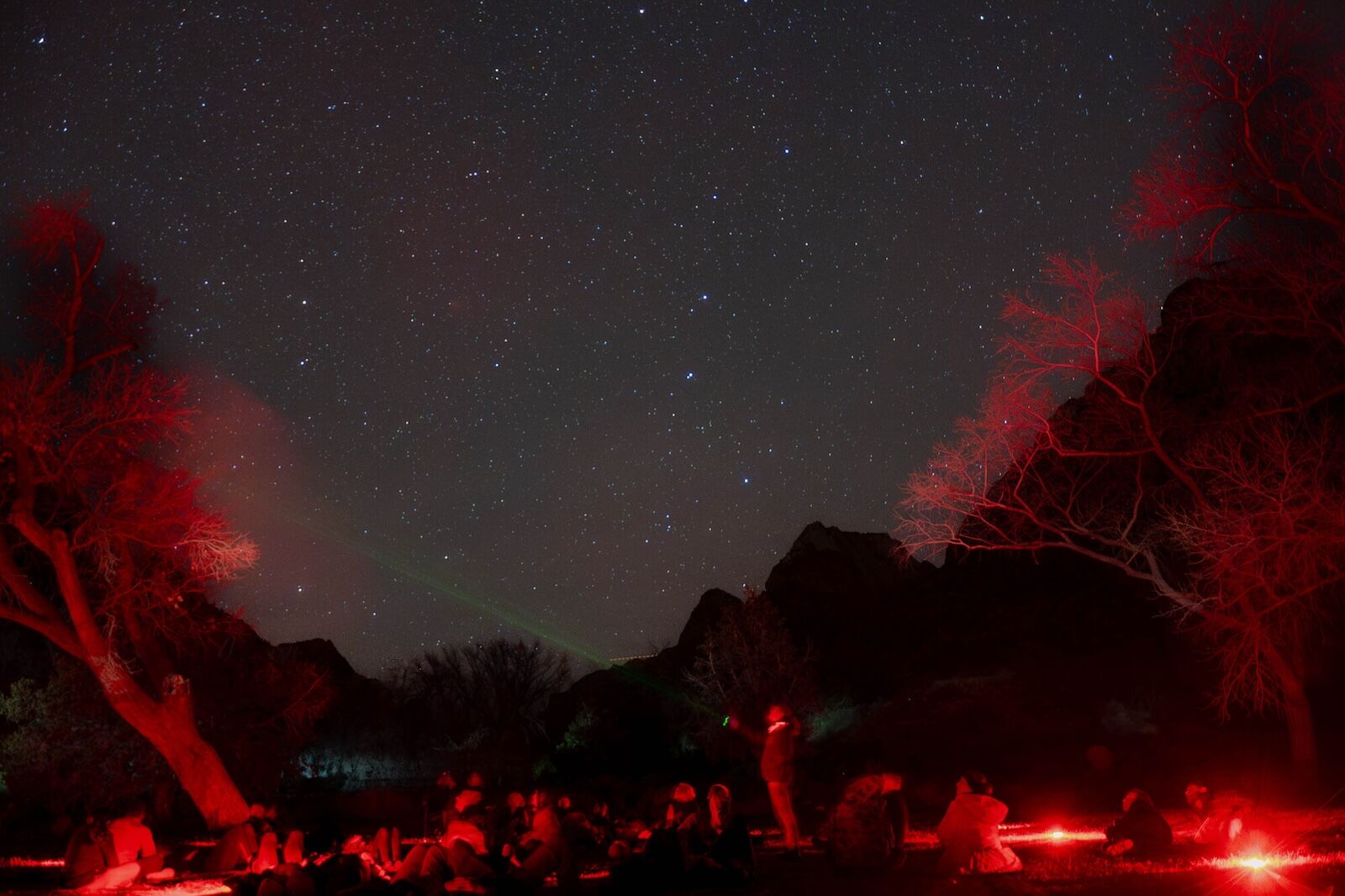
A group of people at a night sky program in Zion National Park, Utah. Photo: Zion National Park/NPS/Serena Wurmser
One of the most accessible activities in national parks is stargazing. For most Americans who live in cities and suburbs, national parks offer a rare opportunity to witness the cosmos in all its glory, far removed from urban light pollution. Many parks have earned designations as International Dark Sky Parks, indicating they have exceptional night sky viewing conditions. Death Valley National Park, for instance, is a Gold Tier Dark Sky Park, and Texas’ Big Bend National Park has the least light pollution of any park in the contiguous United States. According to the park, you can see up tp 2,000 stars on a clear night, compared to just a few hundred in urban areas.
Many national parks also have stargazing events, including ranger-led programs and astronomy festivals (and will likely have more during events like National Park Week 2025).
- In California? Here’s why Joshua Tree is one of the best stargazing destinations in the US
- Plan a trip to one of the 11 best national parks for stargazing (including Joshua Tree)
- Here’s your cheat-sheet to the best night sky events to catch in 2025
- Read why you may want to head to Mesa Verde National Park for unique stargazing
- If you’re looking to get more into stargazing, you may want to attend the Joshua Tree Night Sky Festival
- Did you know stargazing is even better in the winter? Here are the 8 best US national parks for stargazing in winter
- Did you know little-known Vermilion Cliffs is one of the best remote places to stargaze in the US?
- Hooray for Zion National Park, which became a Dark Sky Park in 2021
8. National park hotels are unique and historical
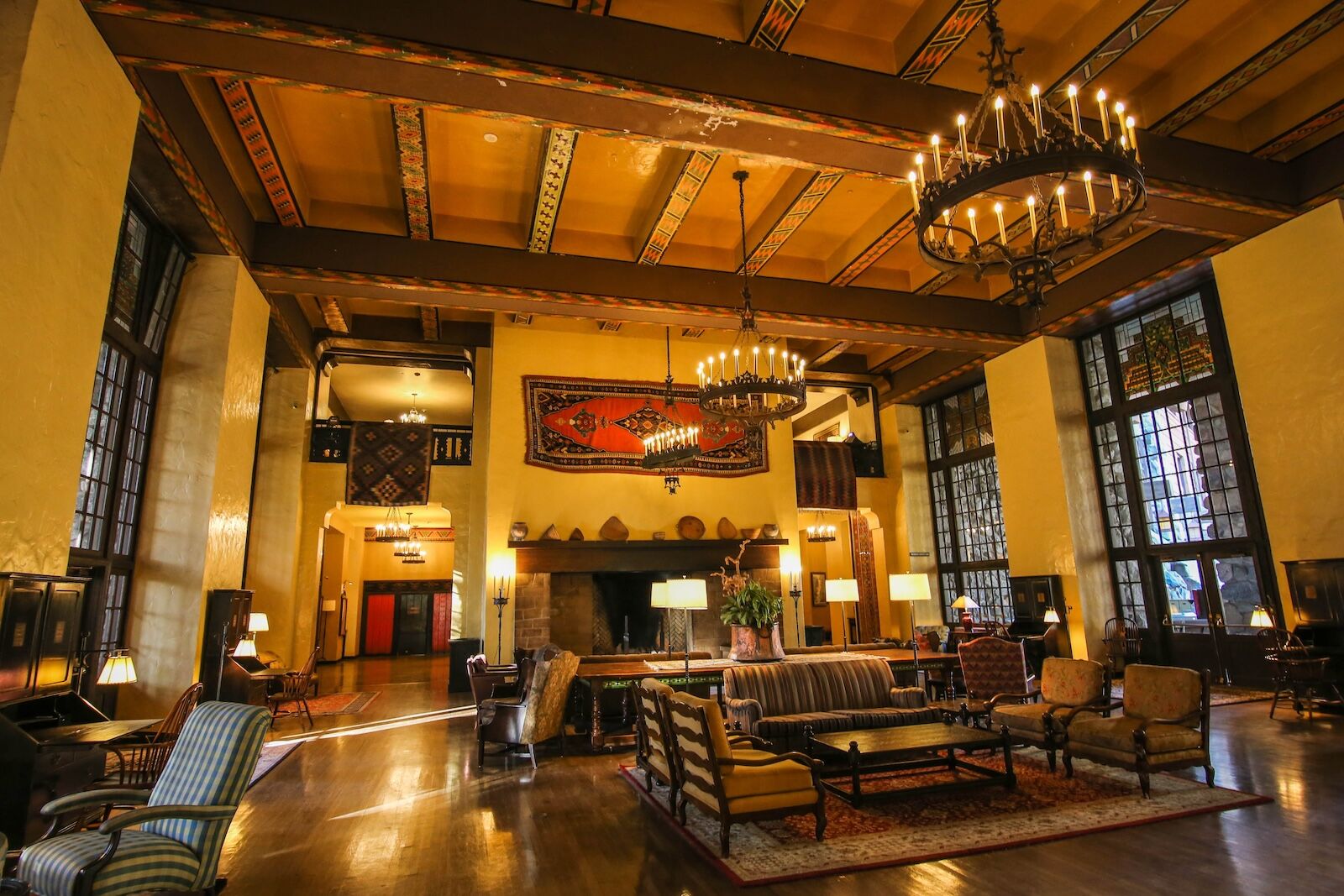
The interior of the Ahwahnee Hotel, Yosemite National Park. Photo: Suzie Dundas
Some of the Matador Network team’s favorite stays have been in hotels inside or just outside the boundaries of national parks. Many of these properties offer a distinct blend of history, architecture, and proximity to stunning natural landscapes, making them a special part of the park experience you won’t find in too many other settings.
Inside the parks, iconic lodges like Yellowstone’s Old Faithful Inn and Yosemite’s Ahwahnee Hotel stand as masterpieces of “parkitecture,” a rustic architectural style from the early 1900s almost exclusive to national parks in the US. The Old Faithful Inn, built in 1904, is one of the largest log cabins in the world, with a seven-story lobby and a massive stone fireplace. And staying at the Ahwahnee in Yosemite is like stepping back into the elegance of the 1940s.
But not all national park hotels have to be wildly expensive. While Glacier National Park is home to the beautiful lakefront Many Glacier Hotel, it’s also home to the Swiftcurrent Motor Inn, with more of a “roadside motel from the 1950s” vibe.
Just outside park entrances are some pretty appealing hotels, too, whether you want extreme luxury, or just a budget-friendly place to crash after a long day of hiking.
- The tiny town of Wrangell, Alaska, may be the quirkiest gateway town within NPS
- Daydream about planning a trip to a brand-new domed glamping hotel near Bryce Canyon
- We rounded up 7 national park hotels everyone should stay in at least one time
- If you already know which park you want to visit, check out the best hotels near Yellowstone National Park, Bryce Canyon National Park, Rocky Mountain National Park, Arches National Park, Joshua Tree National Park, Glacier National Park, Zion National Park, Great Smoky Mountains National Park, Death Valley National Park, and Acadia National Park (whew!)
- Read how Marriott Bonvoy made it easier for members to book hotels near US national parks
- Read about the historic Wawona Hotel in Yosemite, now closed indefinitely
- Dream about staying at the pretty Rush Creek Lodge, just steps from Yosemite’s entrance
- Or check out the more affordable (and super-trendy) El Capitan Hotel near Yosemite
9. Some of the country’s best glamping is near national parks
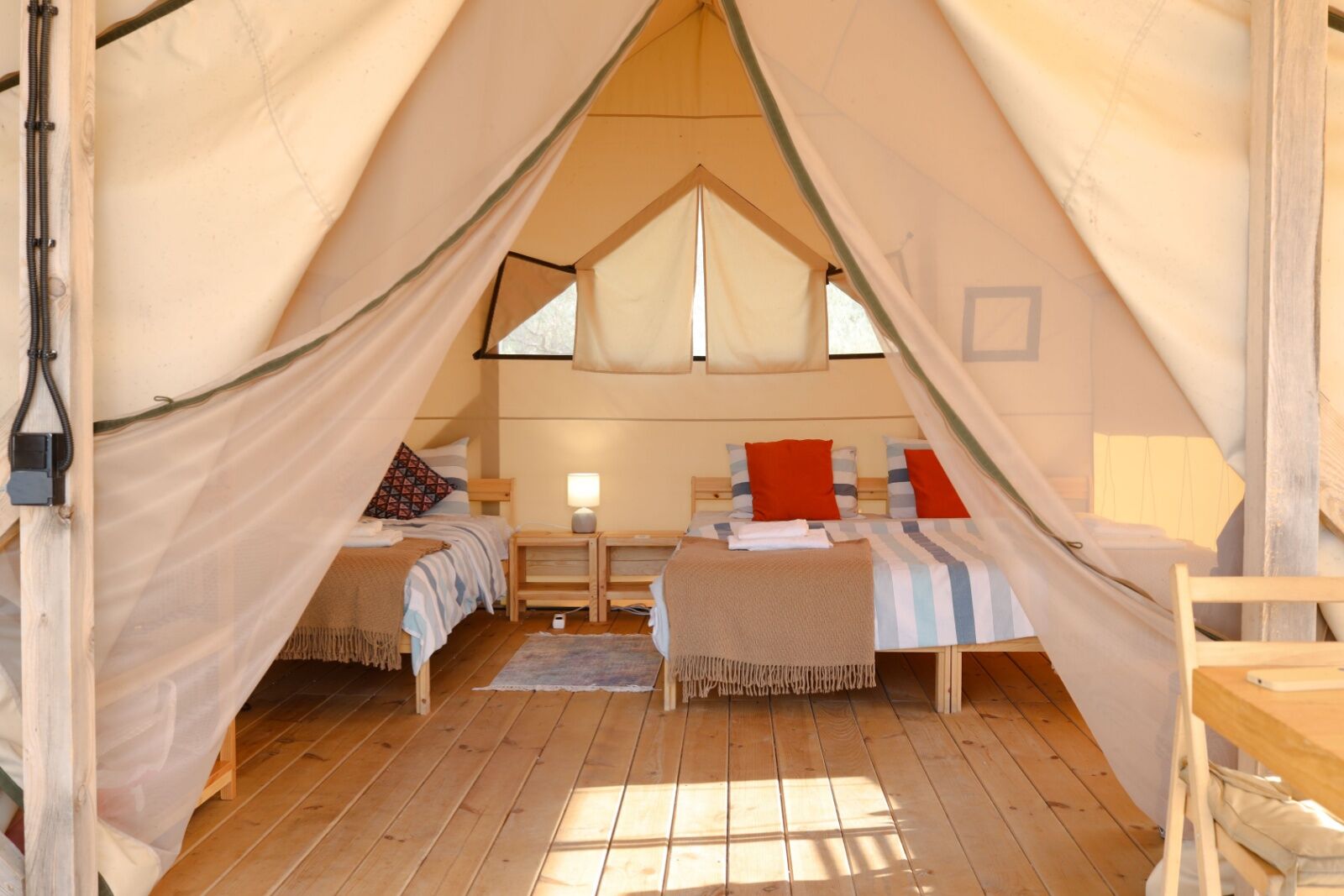
Photo: ShineGraphics/Shutterstock
Glamping near national parks has surged in popularity, probably because it offers an appealing balance of outdoor adventure and luxe comforts. The increased interest in glamping has led to a wide variety of unique and boutique hotels, from off-the-grid eco-domes to safari tents to opportunities to sleep in a vintage Conestoga wagon. Glamping is a bit more connected to nature than staying in a hotel, and many glamping hotels include activities to help travelers play outside, like yoga classes and group bonfires in the evenings. Travelers can choose from well-known brands like Under Canvas and Autocamp, or use Airbnb to rent one-of-a-kind glamping options in towns just minutes from park gates. And if cabins are your thing, well, is there anything more perfect for a national park vacation than renting your own private cabin in the wilderness? We don’t think so.
- Read about the dreamy new luxury glamping resort opening near Acadia National Park
- Not sure where you want to go? These are five of the coolest new glamping resorts to book this year
- Spoiler: the Grand Canyon has some of the coolest glamping resorts around
- If cabins are your vibe, check out the best cabins near Zion National Park, Great Smoky Mountains National Park, Yosemite National Park, and Rocky Mountain National Park.
- For a unique stay, you may want to head to this new geodesic dome resort super close to the Grand Canyon
- If you love the AutoCamp brand, you’ll be pleased to learn it just opened two more at extremely in-demand outdoor locations
10. National Parks are affordable, classic family vacations
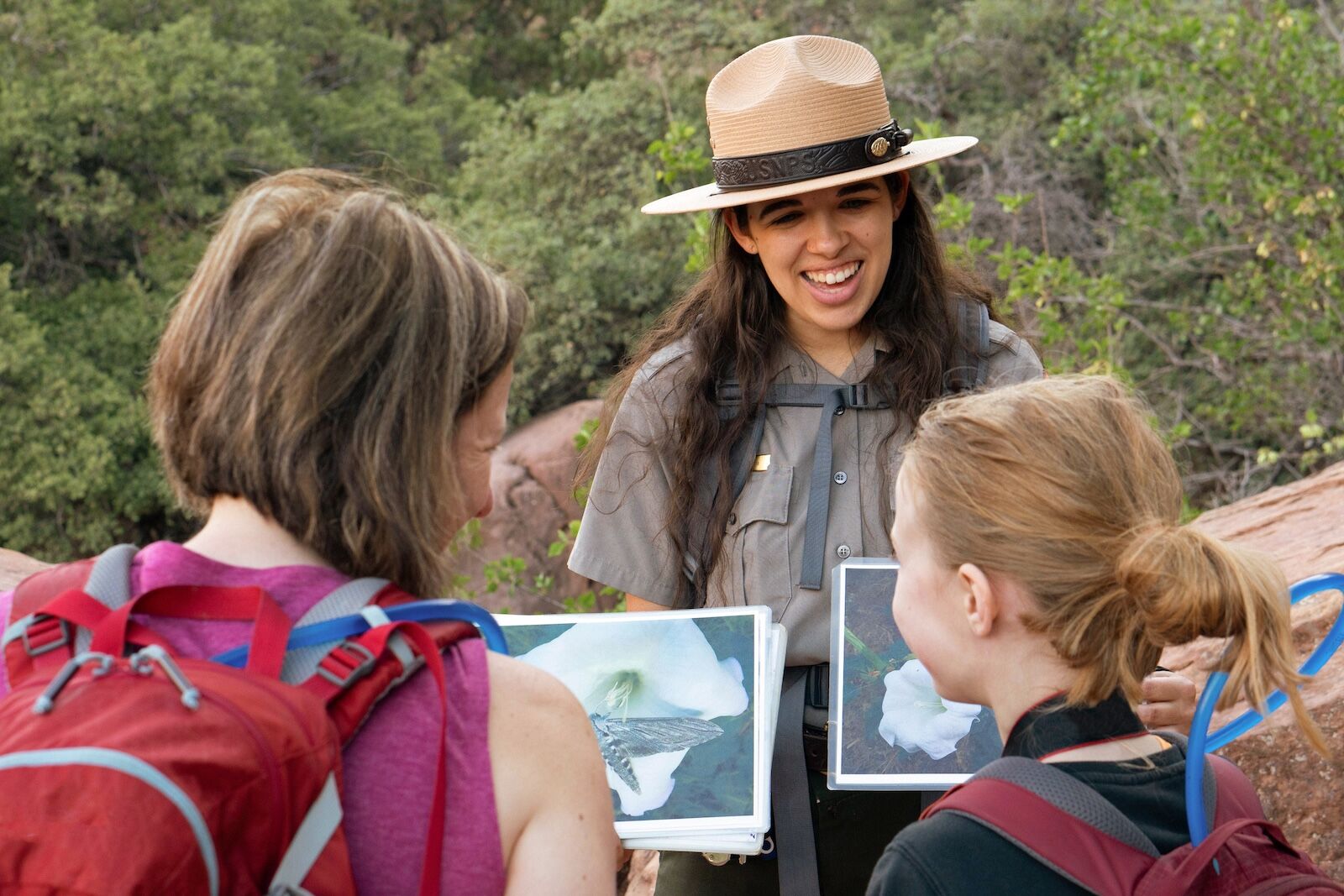
Photo: Zion National Park/NPS/Hazel Harris
US national parks can be some of the best family vacations in the country. For the price of a single entry fee (or free, if you have a 4th grader in the family), you can spend all day exploring dramatic landscapes, taking advantage of free ranger programs and family events, and making s’mores at an outdoor campfire. Campsites are often just $15–30 per night, and many parks have junior ranger programs, ranger-led activities, and accessible hiking trails designed for all ages and skill levels.
Instead of spending hundreds on amusement park tickets or flights, families can pack a cooler, load up the car, and spend a week stargazing in Zion or hiking in Shenandoah. And no matter what your child is interested in, be it tidepools, fossil beds, waterfalls, or even dinosaurs, you’ll probably be able to find it at a national park site.
- Beat the California crowds and spend the perfect family weekend at Sequoia National Park
- If you have a 4th grader in the family, here’s how they can get a free National Park Pass
for the whole family - Read on how to take a first backpacking trip with kids where they (and you) will actually have fun
- Little-touristed South Dakota is one of the best states in the country for a family road trip. Here’s why.
- We know pets are family, too, so here are 10 national parks You can explore with your dog.
- Read up on 7 family travel resolutions that will make your trips more fun this year
11. The outdoor recreation opportunities in US national parks are world-class
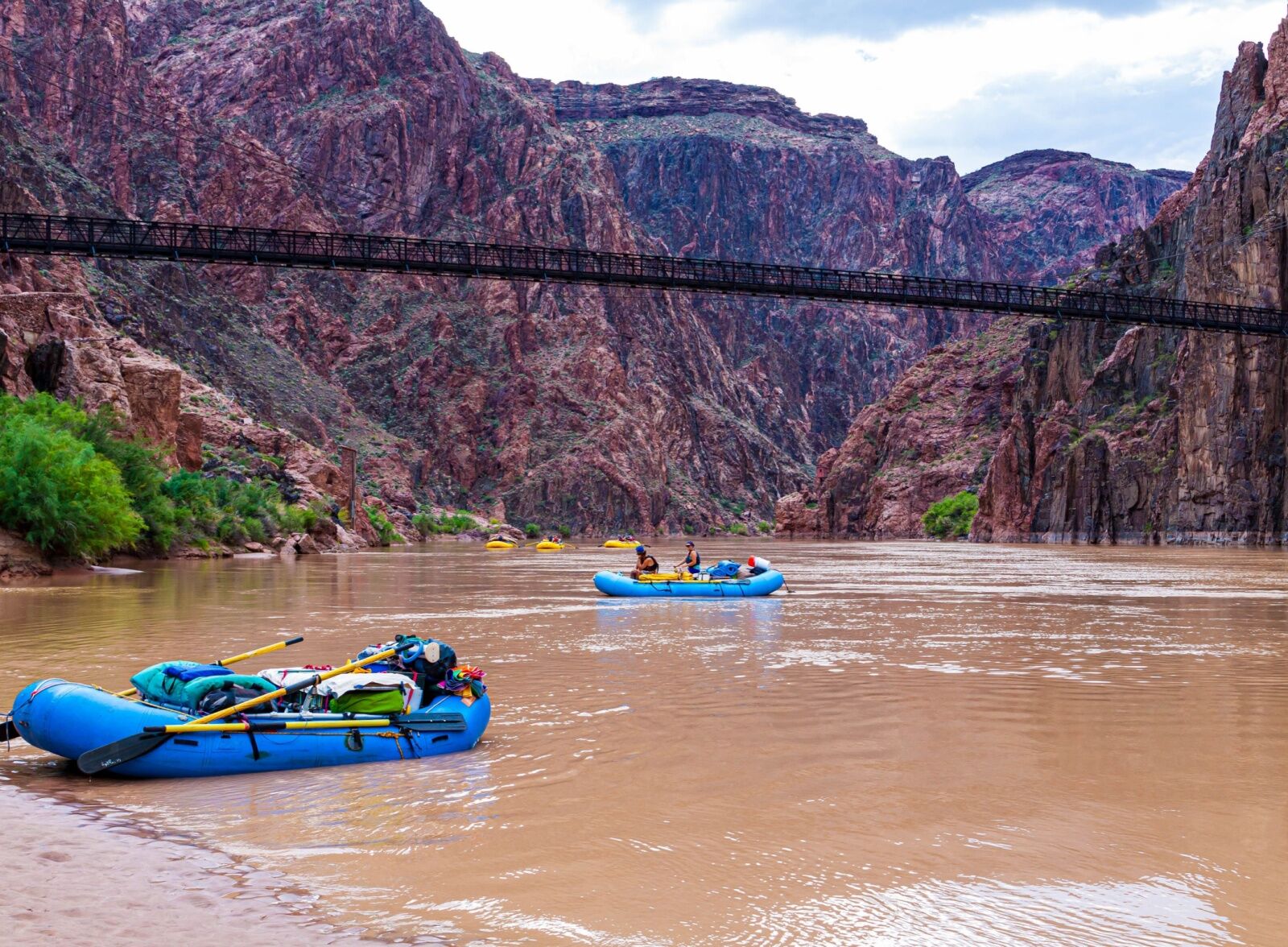
Rafting in Grand Canyon National Park. Photo: Billy McDOnald/Shutterstock
While hiking is often the headline act, US national parks have way more to do than just hitting the trails. From paddling to backcountry skiing, national parks are made to accommodate as many outdoor pursuits as possible. Climbers flock to the granite domes of Yosemite Valley, cyclists ride the rim of Crater Lake in Oregon (or, if you time it right, famous Going-to-the-Sun Road in Glacier), and kayakers and paddleboarders are common sights on alpine lakes. You can even scuba dive and snorkel in many national parks. National parks are generally safe places to try new activities, and often, parks have their own organizations and classes that offer lessons within park boundaries, like California’s Yosemite Mountain School.
- This little-visited national park is one of the most epic in the world if you’re a scuba diver
- West Glacier, just outside Glacier National Park, is a fly-fishing dream. Here’s why.
- Read about all the adventures available in Kenai Fjords National Park, including epic paddling and boating
- If you’re a backcountry skier, here are the parks with the sickest winter lines
- We were thrilled when New River Gorge became a national park as it’s home to absolutely fantastic rock climbing
- These are the best national parks for whitewater rafting, whether you’re a pro or first-timer
- Have you skied in this historic, cute-as-can-be ski resort inside Yosemite National Park?
- Read up on why Death Valley National Park as some of the most extreme road cycling in the country
- Early risers know parks like Rocky Mountain National Park are best before 9 AM. Here’s why.
12. Some of the coolest Airbnbs in the country are near national parks
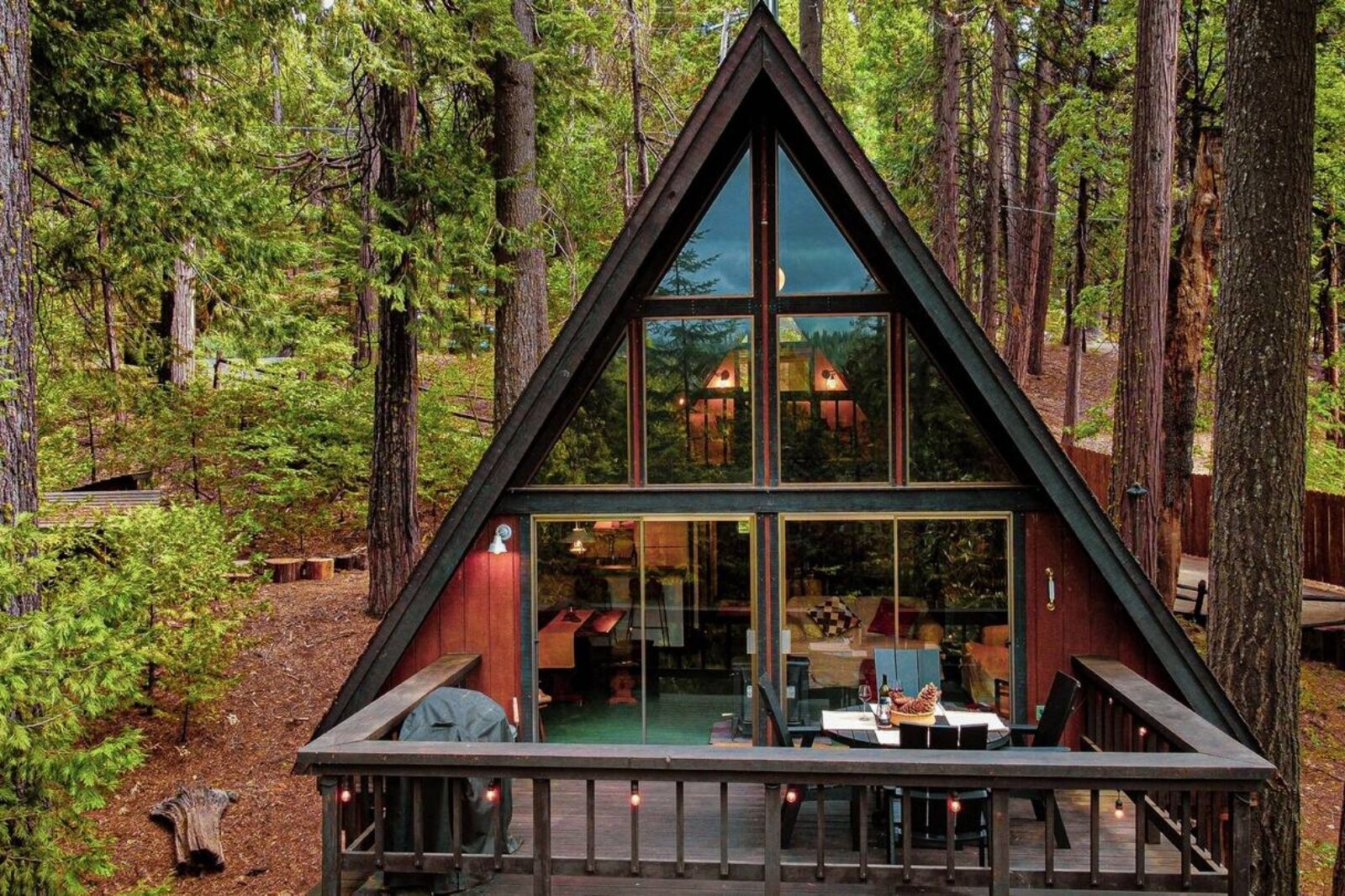
Photo: Airbnb
Airbnbs near national parks tend to offer something that typical vacation rentals can’t: proximity to some of the most spectacular scenery in the country. That could be in the form of a glass-walled cabin near Zion, a solar-powered tiny home just outside Joshua Tree, or a beloved family cabin in the shadow of the Smokeys. Many are run by locals who know the best trails, viewpoints, and hidden spots nearby, and having a full kitchen can help you save big on bringing your own snacks and picnic lunches. Some rentals even come with extras you can use to enhance your getaway, like backpacks and hiking gear, telescopes, or even kayaks and paddleboards. We love national park Airbnbs for their perfect blend of nature, comfort, and space for the whole gang.
- The Best Airbnbs Near Pinnacles National Park
- The Best Airbnbs Near Yellowstone National Park
- The Best Airbnbs in Estes Park, Colorado
- The Best Airbnbs Near Olympic National Park
- The Best Airbnbs Near Death Valley National Park
- The Best Airbnbs Near Shenandoah National Park
- The Best Airbnbs Near Bryce Canyon National Park
- The Best Airbnbs Near Arches National Park
- The Best Airbnbs Near White Sands National Park
- The Best Airbnbs Near Big Bend National Park
- The Best Airbnbs Near Grand Teton National Park
- The Best Airbnbs Near Yosemite National Park
- The Best Airbnbs Near the Grand Canyon
- 11 Magical Airbnbs Near the Redwoods and Sequoia National Parks
- The Best Airbnbs Near Saguaro National Park
- The Coolest Cabins You Can Rent in Great Smoky Mountains National Park

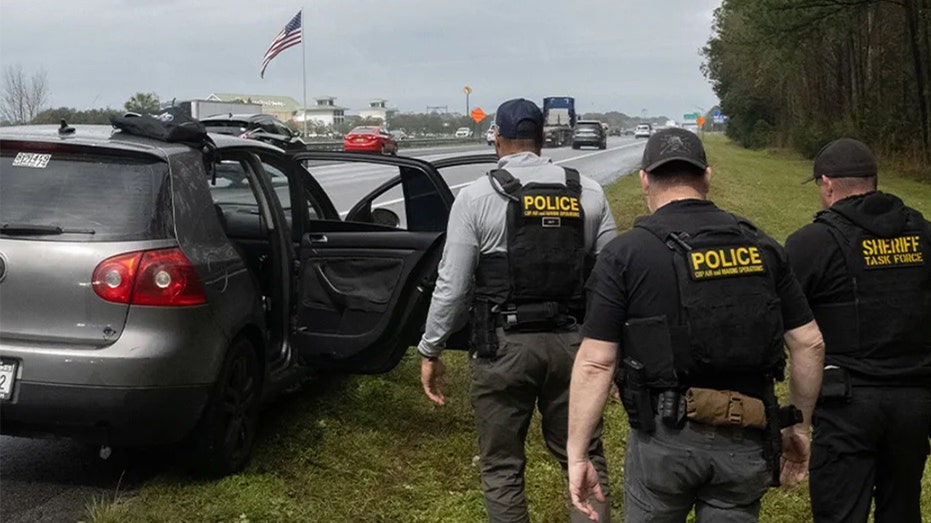

















_Tanapong_Sungkaew_via_Alamy.jpg?width=1280&auto=webp&quality=80&disable=upscale#)




















